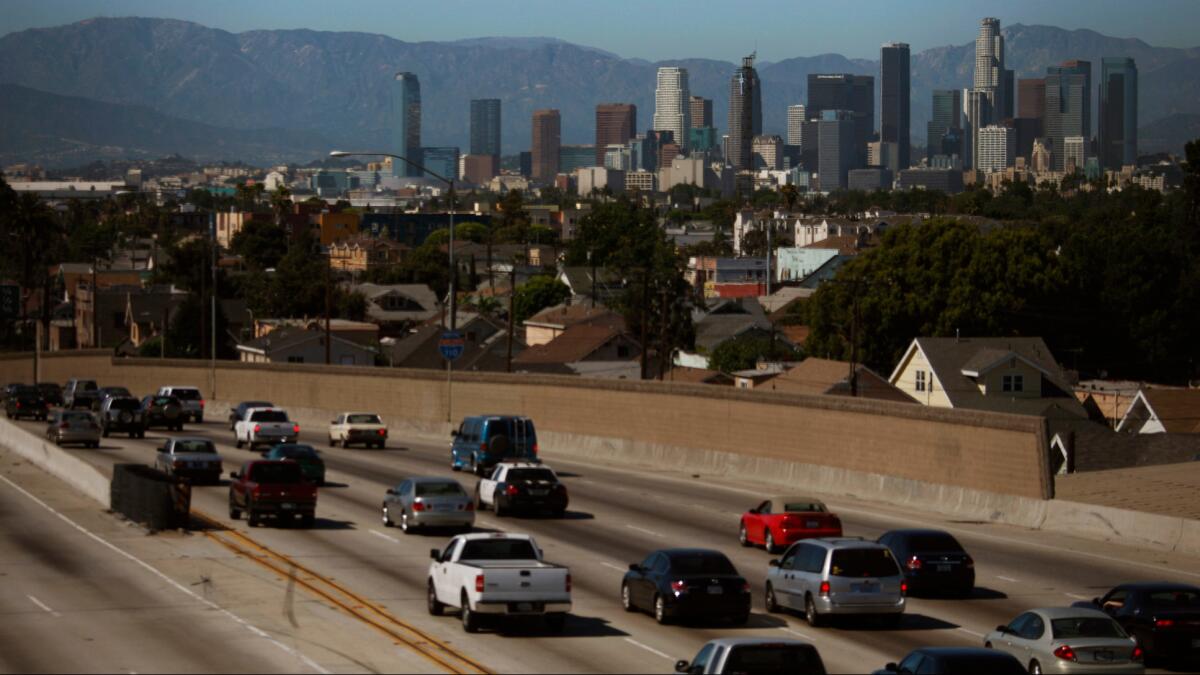SoCal air quality regulators mulling hike in vehicle registration fees for smog reduction

Air quality regulators are considering seeking an increase in vehicle registration fees for millions of Southern California drivers to help pay for smog reduction programs.
The idea, though still in preliminary stages, would be one component of a funding proposal under development by the South Coast Air Quality Management District as part of a major pollution-reduction plan, agency officials confirmed Wednesday. That plan will guide efforts to reduce emissions in the nation’s smoggiest region over the next 15 years.
Increasing annual vehicle registration fees collected from more than 10 million drivers across Los Angeles, Orange, Riverside and San Bernardino counties by $30 would generate an additional $300 million a year for pollution-reduction programs, AQMD Acting Executive Officer Wayne Nastri said in an interview Wednesday.
The South Coast air district currently collects $2 per vehicle in annual registration fees through the Department of Motor Vehicles. That’s less than other parts of the state with similar air pollution problems, such as the San Joaquin Valley, where drivers pay an extra $12 a year for local air-quality improvement projects.
A draft plan released in June by the South Coast district proposes cutting smog-forming emissions from cars, trucks, oil refineries, ports, logistics centers and an array of other sources largely through voluntary, “nonregulatory” measures that encourage, rather than force, polluters to adopt cleaner technology. The plan, which could go to a vote of the AQMD governing board as early as December, relies on finding $1 billion a year for emissions-cutting incentive programs — a 10- to 20-fold increase over what is spent today.
In recent months, that plan has encountered skepticism from environmental groups and some members of the South Coast air district governing board, who criticize it as unrealistic. While its industry-friendly approach has garnered support from regulated businesses, environmentalists have urged a stronger focus on emissions-cutting rules and regulations.
The plan targets ozone, the lung-searing gas in smog that triggers asthma and other respiratory problems. Ozone reaches the nation’s highest levels in Southern California’s inland valleys and mountains. To meet a key federal deadline for reducing the pollutant, the region must slash emissions of smog-forming nitrogen oxides by 2031.
Nastri emphasized that a vehicle registration fee hike is only one of a broad range of potential federal, state and local funding sources the agency is evaluating for use in fighting smog. A more detailed outline is expected by October, he said.
“Right now, we’re looking at the number of vehicles in the region, we’re just postulating what the potential revenue would be if we were to say 30, 40, 20, 50 [dollars],” Nastri said. “We’ll figure out what’s reasonable, what’s not reasonable.”
At a public meeting earlier this month, however, air quality board chairman William Burke said that the $30 vehicle registration fee suggested by Nastri would not be enough and that he has been discussing a $60 fee.
“Nobody wants to pay $60, but everybody says, you know, that would cure the problem,” Burke said at an air district committee meeting on Sept. 9. Burke could not be reached for comment Wednesday.
Imposing a vehicle registration fee hike would require action by state lawmakers. Because it would be considered a new tax, it would have to pass with a two-thirds majority in the legislature.
Adrian Martinez, staff attorney for the environmental law nonprofit Earthjustice, criticized the idea of raising vehicle registration fees as “verging on political fantasy.”
“Our air regulators should instead do what they do best, which is requiring large polluters to clean up our air,” he added.
Nastri acknowledged that “if we actually go to the legislature, we’re facing some big challenges,” including competing requests for funding for transportation, infrastructure and other critical projects. “But we believe that air quality and public health should rank right up there.”
Nastri added that the agency is pursuing a targeted approach for pollution-reduction fees that would seek to place more of the burden on high-polluting sectors, such as heavy-duty trucks, and less on low-income communities and those who drive electric vehicles.
“We don’t want those least able from an economic perspective to pay a majority of the cleanup cost that we’re facing in the basin,” Nastri said.
Nastri has previously proposed asking Congress to create a national fund for cleaning the regions with the most polluted air, an idea modeled on the federal Superfund program for hazardous-waste sites. He has also suggested tapping money from the state’s cap-and-trade program or from Volkswagen’s settlement with regulators over emissions test-cheating software on diesel vehicles.
There is some precedent for raising vehicle fees to fight smog.
San Joaquin Valley air quality regulators have raised more than $133 million from drivers since 2012 by imposing a $12 increase in annual vehicle registration fees, a spokeswoman said. The fees, assessed as part of a U.S. Environmental Protection Agency-required penalty, are used to pay for cleaner cars, trucks, buses and farm equipment.
When the South Coast air district was faced with a similar EPA penalty for missing an ozone-reduction deadline in 2010, it arranged to use money for local air quality improvement projects as credits rather than imposing tens of millions in fees on area businesses or drivers.
An analysis released by the South Coast district last month as part of the agency’s clean air plan found that the health benefits of meeting federal pollution reduction deadlines, including prevention of thousands of early deaths, emergency room visits and missed school days, would far outweigh the billions in costs to industry, the government and consumers.
More to Read
Sign up for Essential California
The most important California stories and recommendations in your inbox every morning.
You may occasionally receive promotional content from the Los Angeles Times.











